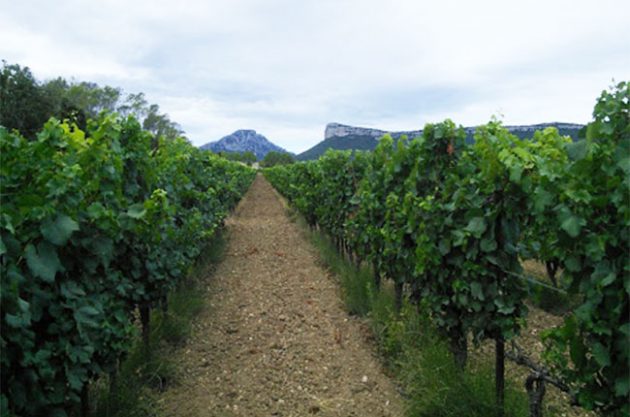
Jefford on Monday: Languedoc’s cool kid
Andrew Jefford bikes up the road to Pic St Loup.
I seem to have neglected the back garden. Not my own (we’ve only just moved house); this blog, though, has never tackled my local vineyard region of Pic St Loup. When the zone’s former president, Guilhem Viau of Bergerie du Capucin, wrote to invite me to a domain celebration a couple of months ago, a chance came to rectify the omission.
Disaster and triumph have marked the Pic’s recent history. The disaster came on August 17th 2016. I remember it well: gathering clouds of such drama during the early afternoon that I rushed outside to photograph them. Shortly afterwards, a torrent of hailstones which looked like flattened golf balls came clattering out of the sky which, with a violent wind from the north west, trashed around half the total crop of the entire area in less than 30 minutes.

Storm clouds gather on 17 August 2016. Credit: Andrew Jefford.
“It was a tough moment for us all,” remembers Viau. “The village of St Mathieu was unscathed, but Valflaunès lost 70 per cent. In Lauret, it looked like a desert. Everyone did what they could. I tried to buy grapes, but there weren’t any for sale here, so I bought in Languedoc more generally. I lost 50,000 bottles; I never dared work out what it cost. The real danger is not having anything to offer customers. A network of customers takes an enormous amount of work to create. I hope it only happens once in my lifetime.”
The timing couldn’t have been worse since the long-awaited triumph of an appellation of its own for Pic St Loup finally came at the end of January 2017 – and 2016 would have been the first ‘appellation vintage’. Fifteen years had gone by since the dossier was delivered to the authorities; it had been much revised subsequently, and the accolade was overdue. The Pic, I suspect, will prove in the long run to be one of the most sought-after zones of the Languedoc, producing perfumed, balanced wines of fresh constitution and poise as well as ample ‘garrigue’ character. They can outperform many Languedoc peers. By way of recent example, the 2013 Ch de Lascaux Les Nobles Pierres (a Syrah with 20 per cent Grenache) won a Platinum medal in September’s Decanter Asia Wine Awards.
What are the advantages of the Pic? Amongst all of the Languedoc AOP zones, it claims to be coolest and the wettest (though Limoux might dispute that); indeed Guilhem Viau suggests that its heat summation and rainfall figures — GDD totals of 1550-1650 and up to 1,000 mm of rain per year — are not far adrift of those of the Northern Rhône. Many of the leading wines in Pic St Loup do indeed showcase Syrah in blends, and the Pic St Loup style of Syrah has a lift and purity to it which contrasts with the citrusy exoticism (teetering, sometimes, into corpulent torpidity) this variety can exhibit in warmer Languedoc locations like St Chinian or La Clape. The Mediterranean and the placid Golfe du Lyon is only half an hour away, but don’t be fooled: the region in general has more of a continental than a maritime climate, with cold winters, warm summers and swift spring and autumn transitions. That, too, is a pattern that Syrah likes.
The fact that France’s eighth largest city, Montpellier, lies half an hour south of Pic St Loup is both an advantage and a challenge. It helps sustain wine sales and prices – but it means that winegrowers have to fight property developers, since the whole appellation lies within easy commuting distance of what has been France’s fastest-growing metropolis over the last half-century (Montpellier has doubled in size since 1962).
It’s also a beautiful area, dominated by the tilted limestone block of Pic St Loup itself (658 m) and the long scarp line underneath the Causse of Pompignane, most visibly marked by the cliff of Hortus opposite Pic St Loup. If you’re someone who believes that limestone makes the greatest of all soil media for vines, Pic St Loup is a Languedoc reference, since almost every vineyard is based on some form or other of pebbley limestone or finer textured limey marl. My guess is that many of these soils (and particularly the beautifully drained, deep ‘gravette’ soils which stretch away in an alluvial fan or bench near the little Gardois village of Corconne, to the north of the appellation) have yet to give their best. The vineyards punctuate airy scrub and forest, profusely scented with thyme and rosemary, and as green in winter as in summer thanks to Aleppo pine, holm oak, strawberry tree, butcher’s broom, mastic, phillyrea, cade and box – a biome I never tire of walking in. There’s ample tourist potential here.

Guilhem Viau in Bergerie du Capucin vineyards. Credit: Andrew Jefford.
Viau, whose term as Pic St Loup president came to an end in 2016, runs Bergerie du Capucin, recently awarded the Trophy of the Grands Vins de France competition. This goes to the domain winning the most medals in a particular region over the previous five years of the competition – five gold and four silver for the top cuvées in Viau’s case, beating any other contender from the whole of Languedoc and Provence. It’s been a rapid ascent: the domain only came into being in 2008. It now has 15 ha in three different sectors of the appellation.
It was singled out for the Trophy via medals for its top red wines, the unoaked Dame Jeanne and the oaked Larmanela; both are indeed very good (see below) and not remotely clodhopping. The single wine from Bergerie du Capucin which most impressed me, though, was not a red – and it poses an interesting question.
Pic St Loup is at present an appellation for red and rosé only: those were what sold best and attracted most attention when the application process began, back in the 1990s. I was struck, however, with Viau’s 2008 white Dame Jeanne: one of the most successful aged Languedoc whites I’ve ever tasted. It’s not illogical to think that one of the coolest, wettest zones of Languedoc, with fine, pure limestone and lime marl soils, might be well placed to produce outstanding white wines in the years ahead.
That Dame Jeanne white, though, is a blend of 70 per cent Chardonnay with the balance from Viognier, and other leading whites from the Pic St Loup zone (including the Domaine de l’Hortus Grande Cuvée white) are based on a similar blend. Would Pic St Loup ever be allowed to sanctify such a blend with an appellation of its own? Politically, I doubt it; Burgundy is not happy to see ‘new’ French appellations staking a claim to Chardonnay. I’m sure we’ll begin to see Pic St Loup reputations being carved out for fine white wines as well as reds from this zone – but consumers searching them out will have to get used to looking for IGP names such as Val de Montferrand or the more recently instituted St Guilhem le Désert.
Tasting Bergerie du Capucin
White wines
Dame Jeanne Blanc, IGP St Guilhem le Désert 2016
This is normally an (unoaked) blend of Chardonnay with around 20% Viognier, but the August hail meant that Viau had to source from friends as well as from the domain, and the blend exceptionally contains five per cent Roussanne and Marsanne in this vintage. Pale gold, with quiet scents of acacia, mint and thyme. It’s vivid, apple-fresh and lively on the palate, with plenty of perfumed intricacy to add charm. Wholly successful. 91
Larmanela Blanc, IGP St Guilhem le Désert 2014
The white Larmanela is quite literally a ‘tête de cuvée’, in that it is drawn off from the upper part of the tank after settling; it is also the earliest picked portion of Chardonnay, and is fermented in new Radoux barrel specially selected for this purpose. Lots of efforts, then, but for me it is both over oaked and rather drivingly acid. Perhaps time wills soften the wine, but my suspicion is that 12.5% in this location is just too early a pick. 89
Dame Jeanne Blanc, IGP Val de Montferrand 2011
Formerly sold under a different IGP name, but this is the same blend of Chardonnay and Viognier. The Viognier character comes through with ample aromatic sweetness aromatically; on the palate, by contrast, the poise and finesse of the Pic Chardonnays sing out. 89
Dame Jeanne Blanc, IGP Val de Montferrand 2008
Full gold in colour now, with ample Chardonnay classicism: grain, bread, a delicate nuttiness. On the palate, it’s balanced, lively and soft: a subtle milky richness adds complexity and sensuality to clean, lemony fruit lent intrigue by some bottle age. The fruit quality is worthy of comparison with traditionally styled Margaret River Chardonnays, a warm village Meursault or even a Kumeu River – and a striking success for Viau’s debut Chardonnay vintage. Proof that the Pic has fine white-wine potential. 93
Red wines
Dame Jeanne Rouge, Languedoc-Pic St Loup 2015
A blend of Syrah with 25 per cent Grenache and 5 per cent Mourvèdre, this is a pure, bright and zesty red blend, entirely aged in tank. There’s a wildflower and thyme sweetness to the aromas, a little meaty richness and a twist of orange peel, too – but everything in moderation and just proportion. Pure and poised. 91
Larmanela Rouge, Languedoc-Pic St Loup 2014
This pure-Syrah cuvee, aged in mainly used 400-litre casks for 16 to 18 months, has mushroom and balsam-lifted fruits; the palate is pungent, perfumed and dancing, full of fresh-cherry lift, and with well-judged, lacework tannins. 92
Larmanela Rouge, Languedoc-Pic St Loup 2011
Prior to 2012, this Syrah cuvée also contained 10 per cent Grenache. Deep, indeed almost opaque, in colour, with sweet, dark, ripe, quietly expressive black fruits. As the aromas suggest, the palate is rich, dense, full, spicy, vivid and harmonious: more evidently generous in conception than Viau’s recent work, but deft and seamless withal. 92
Larmanela Rouge, Languedoc-Pic St Loup 2010
Another tenaciously coloured wine, with black fruit scents of plum and blackcurrant, a little fig sweetness and some menthol among the herbal notes. On the palate, this wine now has ample liquorice and root-spice flavours lent contour and definition by finely stitched acidity and soft tannins. 91
Those wishing to discover more about Pic St Loup might like to seek out the admirably comprehensive bilingual book Le Pic St Loup by Florence Jaroniak and Sharon Nagel (published by Terroirs d’Exception).
